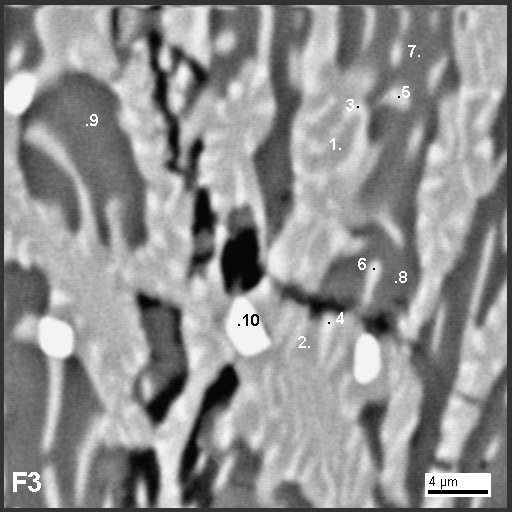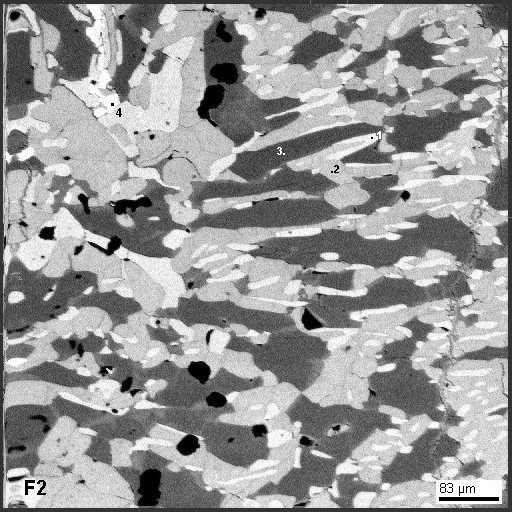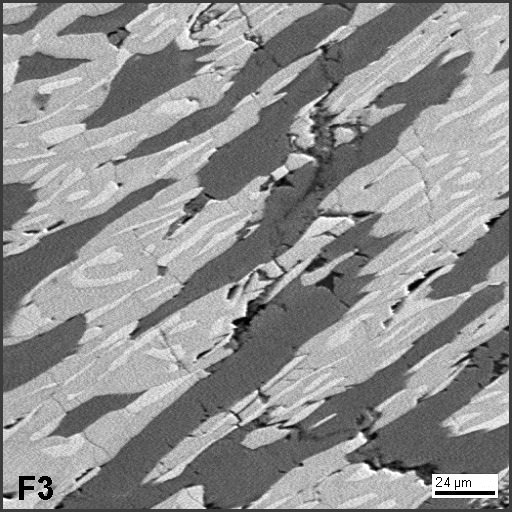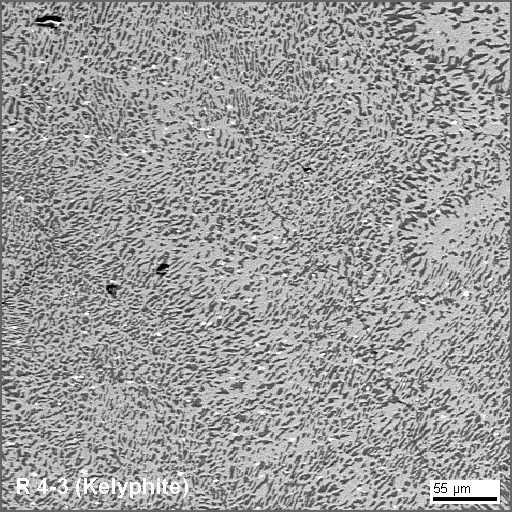PGMs in pyrop-pyroxenites of the Ronda Mantle Block (Betic Cordillera, Southern Spain)
Introduction
More than 20 years have passed already since A.J.Naldrett and J.M.Duke (1980, Science, vol. 208) have proposed a method of comparison of various ultramafic rocks based on correlation of platinum group elements (PGE) in a samples"... on the basis of the elemental abundances in type 1 carbonaceous chondrites (C1)... because they are believed to be the best available indication of cosmic abundances" (p. 1419). The authors of the publication have chosen the space object (chondrites С1) as a basis for comparisons. However long-term practice of chondrite-normalization has shown that these data are frequently used as the information for comparison of various ultramafic massifs as well as for an evaluation of a degree of affinity of above ultramafic rocks to hypothetical substance of the Earth mantle (indirectly through chondrites C1) in dependence "... of the degree of partial melting of mantle peridotite..." (p. 1417).
The choice of cosmic object as a key for comparison of terrestrial rocks is clear, because, as it is paradoxical, there is much more unity of opinions concerning of C1 chondrites rather than relating of chemical and particularly mineral composition of the upper mantle. Moreover there are a lot of opinions concerning of types of the ultramafic massifs which could be confidently compared with undifferentiated and not altered "primary" mantle.
However, it is very important to have the approved idea not so much about elemental but rather about the phase composition of the PGE in mantle, as PGM and their associations in ultramafic massifs of various types essentially differ, that allows, having such starting point, as PGM phase structure in the mantle, to reconstruct the evolution of ultramafic massifs based on PGM mineral associations changing. In this context there is only question: "What the sample from what the ultramafic massif should be studied to get an conception about the PGM in upper mantle"? (Incidentally we shall notice that the phase composition of PGE in some chondrites is investigated better, than in many ultramafic massifs of the Earth. See A.J.Campbell et al., 2001, Geochimica et. Cosmochimica Acta, vol.65, #1, pp. 163-180).
Thus, the main problem of establishment of the phase forms of PGE in mantle breaks up into two individual tasks:
To prove a choice of ultramafic massif and to perform sampling with subsequent study. After the study to choose only samples which are representative for the mantle conditions and could be used for high-sensitivity mineralogical works for PGM determination;
To perform a complex high-sensitive mineralogical study of the chosen samples for an establishment of the forms of PGE presence in mantle rocks.
It’s hard to define which named problems is more complicated, however is obvious, that it’s no sense to start the decision of the second task without the appropriate study of the first problem.
Therefore in the first part of investigation (Part 1: What We Deal With) the main attention is given to a choice and selection of samples for subsequent mineralogical (PGM) works.
Our endless discussion concerning of most "primary mantle" object, was stopped, when we have taken into account only two basic parameters of the massif choice and rules of the sample selection.
It was accepted that investigations would be made only for massifs which contain:
- pyrope peridotite and (or) pyroxenite i.e. the primary mineral associations should confidently be reconstructed and includes the pyrope;
- serpentinization and related low-temperature mineralization should be absent or to be so insignificant, that primary mineralogy of rocks was reconstructed unequivocally even in details. This requirement is caused by the next fact: the probability of the large-scale non-isochemical processes is small in waterless conditions (i.e. the probability of input-contamination of "crustal" elements is negligible), and also mineralogical transformation in the matterclosed system probably will be interpreted correctly by rules of phase transformations within the framework of the classical thermodynamics laws.
|
Tectonic domains and facies boundaries of the S-W part of Ronda peridotite massif
(Contours redrawn after C.J.Garrido and J.-L.Bodinier: J.P., 1999, vol.40, #5)
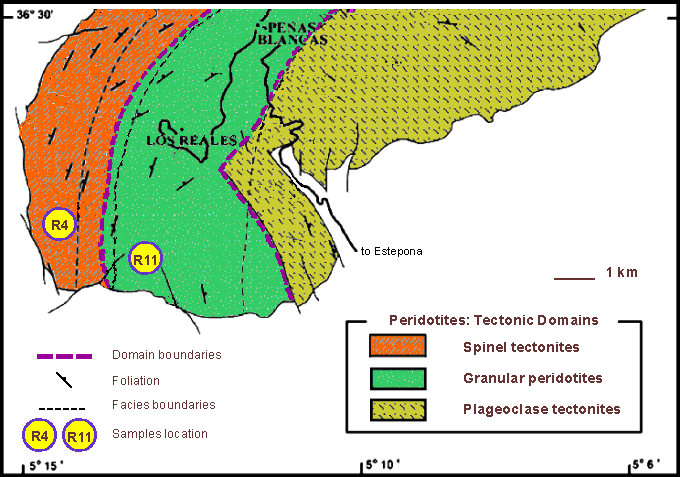 |
It is became obvious after the literature analysis, that peridotite from the Ronda massif in S-W of Spain is a quite suitable object in attempt to determine the "primary mantle" phase forms of PGE: western and northwest parts of the massif are composed by strongly reworked garnet peridotite (pyrop milonites, spinel tectonic domain: Dirk Van DerWal and Reinoud L.M.Vissers, 1996, J.P., vol.37, #1). Peridotite includes thin horizons of pyrope pyroxenites, which in contrast to peridotite do not contain primary olivine and have undergone of serpentinization much less. The processes and mechanisms, which predetermine the presence and association of pyrope peridotite and pyroxenite in western part of the Ronda massif are controversial and are discussed in the literature. However for understanding it is important to emphasize, that neither peridotite, nor pyroxenite of this tectonic domain do not carries indisputable structural, chemical or mineralogical evidences of melting (or depletition - restite presence) during of the mantle block emplacement in the upper horizons of Earth crust (i.e. undersolidus T-P path) and are quite "primary mantle" rocks.
In August - September 2000 from the pyrope peridotite and pyroxenite, and from spinel and granular peridotite we collected samples for high-sensitivity mineralogical works forwarded to establishment of the phase forms PGE in mantle. It was established after the preliminary analysis that all peridotite are differently serpentinized and sulphide mineralization is revealed by a network of microcleavege cracks, filled of serpentine and others hydroxyl-bearing minerals or carbonates. These samples are not the subject for the further study, because even if the PGM would be found, it will be hard or impossible to prove their mantle origin.
Pyrope pyroxenites are given much more favorite chances for above purpose achievement. The degree of serpentinization in these rocks is insignificant (see Figure 1) and primary mineralogy is evidently exists.
|
Figure 1. Images of polished thin sections and bulk chemistry of R4 and R11 samples
|
||||||||||||||||||||||||||||||||||||||||||||||||||||||||
|
R4
|
R11
|
Bulk chemistry
|
||||||||||||||||||||||||||||||||||||||||||||||||||||||
 |
 |
|
||||||||||||||||||||||||||||||||||||||||||||||||||||||
PGE content and C1-chondrite normalization patterns in the samples and in gravitational concentrates of samples R4 and R11 are given on Figures 2 a, b and c.
It is obviously that concentration of noble metals in samples R4 and R11 is very low in comparison with C1 chondrite. However it is more essential to make a preliminary conclusion that the PGE are located not in all minerals composing the pyroxenite because of the PGE concentration is strongly increases after the gravitational concentrates extraction. It is allows to conclude that the PGE are located in rather heavy minerals, which are collected in gravitational concentrates.
|
Figure 2a. PGE abundance in bulk and heavy concentrates of R4 and R11samples
|
||||||||||||||||||||||||||||||||||||||||
|
||||||||||||||||||||||||||||||||||||||||
|
< - below Low Detection Limit (LDL)
|
||||||||||||||||||||||||||||||||||||||||
|
|
||||||||||||||||||||||||||||||||||||||||
|
Figure 2b. C1 normalization patterns in R4 and R11 bulk samples
|
||||||||||||||||||||||||||||||||||||||||
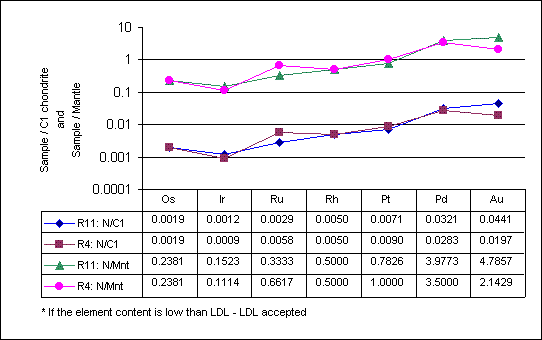 |
||||||||||||||||||||||||||||||||||||||||
|
|
||||||||||||||||||||||||||||||||||||||||
|
Figure 2c. C1 normalization patterns in heavy concentrates of R4 and R11 samples
|
||||||||||||||||||||||||||||||||||||||||
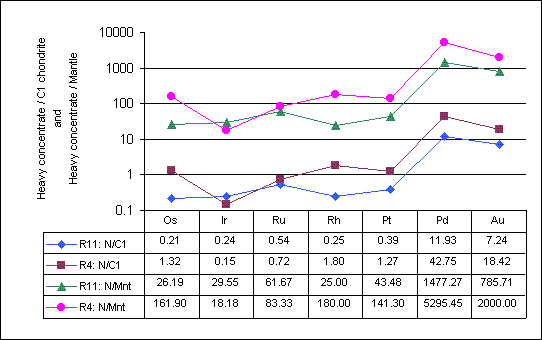 |
Mineralogical study of samples R4 and R11
Sample R4: analytical data
The aluminum clinopyroxene, garnet (pyrope with grain size up to 7 mm) and kelyphitic aggregates and crowns around the garnet are made the bulk of pyrope pyroxenite. The kelyphitic aggregates and crowns consist from symplektitic accretions of smallest metastable phases, their composition is corresponds to various combinations of shpinel-orthopyroxene-plagioclase amount, that is in good correspondence with the data of Tomoaki Morishita, Shoji Arai, Fernando Gervilla (Lithos 57, 2001, pp.143-161). Olivin is not detected in the kelyphitic rims in the sample R4, and plagioclase was not also founded out, diagnosed unequivocally by the chemical composition. Amphibole, similar on chemical composition to kaersutite (brown phases in transmitted light), - is rather late mineral which is founded out both in interstition of pyroxene rock matrix, and in the weak zones (in microfaults) inside garnet grains together with Ti-clinopyroxene. Serpentinization is weak and serpentine is founded only in rare late cracks, cutting all elements of garnet pyroxenite R4 structure.
The kelyphitic crowns are make a significant part of rock volume (Figure 1, up to 40-50 %) and always are located around or in contact to garnet grains. The important structural feature of kelyphite is microcrystals orientation by long axes ~perpendicularly to boundaries of garnet grains, forming a radial-concentric structure of kelyphitic crowns. However orientation of symplectitic grains which general for all kelyphites of rock is absent. This indicates an absence of stress pressure during the formation of kelyphitic crowns: the vector stress pressure leads to directive structures formation in the rocks or trachytic (laminar) masses, if the viscosity-plastic flow was realized.
 R4 1. Transmited light
|
 F1. BSE image of frame 1
|
|
|
|
|
F2. Fragment of F1
(full size available)
|
F3. Marked fragment of F2
(full size available)
|
|
Table 2. Cemistry to analyses, shown on fields F1 and F2
|
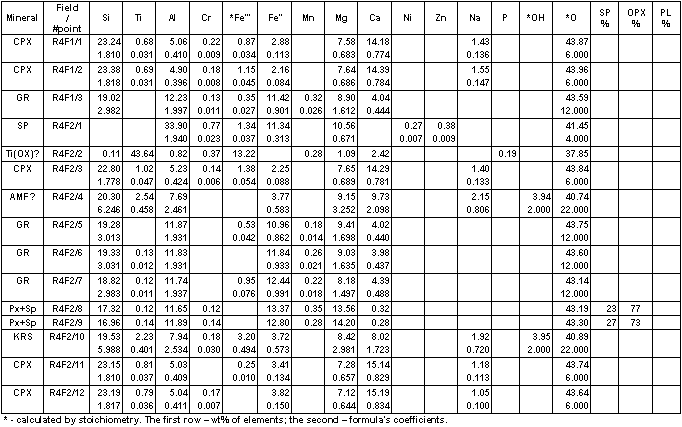 |
|
Table 3. Cemistry to analyses, shown on field F3
|
 |
|
F4. BSE image of frame 4
(full size available)
|
F5. BSE image of frame 5
(full size available)
|
R4 2. Transmited light
(full size available)
|
|
Table 4. Cemistry to analyses, shown on fields F4 and F5
|
 |
The orientation of long axes of microcrystals sheer to boundary of garnet grains demonstrates that at some moment the garnet is became non-equilibrium (reactiveness) relative to pyroxene rock matrix at in ascending mantle block. Recrystallization of frontier domains with formation of kelyphitic crowns was accompanied by mass transfer, and the direction of movement of mass was perpendicular to boundary of garnet grains, that is coincided with lengthening of symplectitic phases. The presence of a gradient of concentration to perpendicular of the boundary of garnet grains is proved also by fact that in contrast to the data of Tomoaki Morishita, Shoji Arai, Fernando Gervilla (Lithos 57, 2001, pp.143-161) our observations demonstrate, that the garnet composition on the boundary of grains surrounded of kelyphitic crowns has a diffusion type zonation (see F2, F5 and tables 2,4) and grains boundary is chemically active, and the minerals of kelyphitic crowns correspond to the new thermodynamic conditions which have entailed garnet recrystallization.
Thus, the analysis of the phase composition and structural features of pyrope pyroxenite R4 demonstrates that according to temporary modified thermodynamic conditions, some of transition is established in R4 from one facies conditions to others: from garnet facies to spinel facies. At that, because of the recrystallization rate was less, than the T-P conditions changing rate - R4 composed by mineral relics of garnet facies as well as new minerals of spinel facies. The almost complete absence of obvious attributes of mass transition of metastable symplektitic accretions of the spinel-ortopyroxene-plagioclase in mineral associations with plagioclase (see F3, Table 3) demonstrates also the very high rate of ascending and cooling of mantle block. This is indicate directly on very high rate of change T-P conditions (cooling) of garnet pyroxenite like R4 at a rise of masses in upper horizons of the Earth crust.
These data are in good correspondence with model of the peridotite block ascending (the dynamic cooling model), suggested by Masaaki Obata (see Journal of Petrology, 1980, vol.21, #3). Meanwhile, we cannot agree with M.Obata that the kelyphitic crowns are generated on a final stage of block cooling: mineralogy of kelyphites from pyroxenite R4 (and partly R11) indicates on T-P conditions of spinel facies, but not about the conditions of low-temperature metamorphic transformations at pressure about 4Kb. Furthermore, it is hard to agree also with the statement contradicting to above model (but stated by the author of the model), that the pyrope garnet appearance occurs by the equilibrium spinel association transformation (reverse order of facies change). This statement is based on the idea that spinel inclusions are observed in pyrope, which for this reason should be considered as later mineral. It is clear from the photo F2 and F5 that the spinel, occurred as inclusions in garnet, certainly associates with titanic phases: oxides, Ti-amphibole (kaersutite) and clinopyroxenes with higher Ti content: ~1wt %. In the thin sections photos (transmitting light) it is clear, that the same phases with titanium (and also ilmenite, see F3) are developed in a rocks matrix, being later minerals in relation to pyroxene and garnet. Therefore, it is more justified to consider inclusions of the spinel-pyroxene-kersutite as a new minerals in a local weakened "opened" (redistribution Ti) zones of garnet grains, where at cooling of the mantle block and at fall of pressure there is a formation of new phases, possibly even on early minerals - inclusions. (We shall remind that if the olivine inclusions occurred in garnet, next way of mineral transformation is possible: Gr + Ol = Sp + 2Px).
Garnet’s kelyphitization is a simultaneous event or relatively later to the time of spinel-pyroxene-kersutite inclusions formation. It’s shown on a photo F5 that at kelyphitization-corrosion of garnet the fine spinel inclusion (F5, point 4) is released. Because of this grain - inclusion is not inside, but on boundary of a garnet grain in a kelyphitization zone (mass transition zone) - it is separated from garnet by diffusion zone (F5, point 3), that proves non-equilibrium and chemically active character of garnet boundary with all surrounding minerals: both kelyphitic minerals, and spinel grain, which was before occurred in garnet.
The data obtained during the study of kelyphitic crowns does not allow to consider the metastable symplectitic aggregates appearance as a result of partial melting of pyrope pyroxenite masses of R4 type, particularly, structural evidences of the melting were did not found despite of all efforts. Meanwhile it is important to emphasize, that in comparison with pyrope, where the masses (atoms) transfer was realize by the diffusion laws (see diffusion boundaries on F2 and F5), - the kinetic of mass transfer at kelyphitic zone is based on other physical processes directed along of concentration gradient (perpendicular to garnet grains boundaries), i.e. based on the process of dissolution–crystallization of micro metastable phases of kelyphitic aggregates.
We know from physics that depending on temperature, - the rates of mass transfer by the crystallizations or diffusions mechanism can differ on many orders, therefore it’s easy to explane the fact, that at high ascending rate (cooling) of mantle rocks the garnet can remain as a relic phase from garnet peridotite facies at the mantle block transportation in conditions of spinel or even plagioclase facies.
The high rate of mass transfer by the crystallizations mechanism allows indirectly (!) to compare the kelyphitic zone with microdomain of melting, as the rate of mass transfer in a liquid is also so high in comparison with mass transfer by the diffusions mechanism. Is this comparison is justified or has only linguistic meaning - further experience will show, however physical properties of kelyphitic aggregates (plasticity, viscosity...) are undoubtedly strongly differ from physical properties of surrounding crystals of garnet and pyroxene. The difference of physical properties of the rock microdomain at pressure gradient (stressful or static) should be the resulted in selective plasticity of rock in macrovolume, as kelyphitic microblocks are able to play a role of greasing and to increase the "selective fluidity" of homogeneous rocks and to resulted in the mantle masses differentiation.
Whether it is possible to explain the presence of garnet pyroxenites layers in peridotites, coexisting together without any features of mantle differentiation?
Sample R11: analytical data
|
F1. Polarized light
(full size available)
|
Despite of similarity of chemical composition of pyrope pyroxenites of samples R4 and R11 (see Figure 1 above), the mineral composition of rocks is different: in a sample R11 the pyrope is already completely transformed to kelyphitic aggregate of olivine-spinel-plagioclase-pyroxene composition. (See also picture R11-2 "Kelyphite" below), and plagioclase is appears by one of the latest phases of this mineral association (see F3 below. Pl - is the darkest phase, SP - the brightest, Opx - middle).
According to the rules of a sample selection specified in the Introduction, the pyroxenite R11 should not be studied in details. However preliminary study has shown that the detected in R4 the fragment of T-P trajectory (the transition from garnet peridotite facies to spinel facies) of the ultramafic Ronda massif can be continued to plagioclase facies if take into account the data on R11.
|
F1. BSE image of frame 1
(full size available)
|
F2. Marked fragment of F1
(full size available)
|
|
F3. BSE image of frame 3
(full size available)
|
F5. BSE image of frame 5
(full size available)
|
|
Table 6. Cemistry to analyses, shown on fields F1 and F2
 |
|
Table 7. Cemistry of silicates to analyses, shown on field F3
 |
|
Table 8. Cemistry of sulphides to analyses, shown on fields F5 and F7 (F7 is shown on F5)
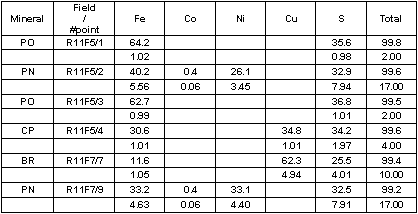 |
The analysis of data obtained for the olivine-plagioclase pyroxenite of the R11 sample shows, that symplektitic kelyphitic phases completely have replaced the garnet and consist from the ortopyroxene, spinel, olivine and plagioclase.
It is important to emphasize, that the olivine and plagioclase, which are not typical for kelyphitic associations of pyrope pyroxenite of the R4 sample, make an essential part of symplektitic associations in the olivine-plagioclase pyroxenite of sample R11, however the olivine Mg number of kelyphitic crowns (72-74 %) is essentially differs from Mg number of this mineral in peridotite of the massif, which according to data of many authors is about 89-91%.
It was mentioned above, that the plagioclase is one of the late minerals crystallizing in the symplektitic associations and, probably, even replaces the earlier ortopyroxene-spinel basement of symplektites (see R11, F3). However, the latest minerals, which crystallize even later plagioclase, are sulfides of Fe, Ni, Cu. (See R11, F5 and Table 8). On a material we have (nowadays), it is impossible unequivocally to distinguish the different generation of sulfide, however it is necessary to note, that the composition of pentlandite occurring in the pyroxene (see F7 inside F5) differs from the composition of pentlandite related sulfide microcracks cutting off plagioclase grains.
Kelyphites as a part of the whole rock: bulk chemical composition
Figure 1 demonstrates that the kelyphitic (symplektitic aggregates) are appropriate elements in structure of pyroxenite and can make up to 50 % of rock volume.
What is it: the kelyphitic (symplektitic) aggregates as a part of a whole rock?
In three photos given below (R4-1, R4-3, R11-1 (kelyphite), the fragments of the symplektitic structures are shown, where by the EPMA technique (ED Spectometer) the bulk chemical composition was determined. (see Table 10). (The same was done previously by D. van der Wal and R.L.M. Vissers, 1996).
On a photo R11-2 the fragment of a photo R11-1 with points of determined minerals chemical composition is shown. (see Table 9).
It is clear from the table 10 that bulk chemical composition of the symplectitic (kelyphites) aggregates in respect to major elements within an error ED of the analysis corresponds to garnet stoichiometry (at least for pyroxenites R4), and just not a simple of garnet, namely of pyrope garnet composition, which we analyzed several times in pyroxenites R4. (see Tables 2,4).
The distinctions of the composition founded as a difference between average total composition of kelyphites and average garnet composition demonstrate that at the retentive cation balance and retentive their total charge (mass balance of anion) symplektitic aggregates are enriched in relation to garnet by one, three- and four valency cations by the reduction of two valency cations. However it is necessary to emphasize, that the changes of chemical composition are negligible. (In passing we shall notice, that the Ca it appears inert at mass exchange).
The fact of a relative constancy of chemical composition allows to consider the kelyphite fragments as a relic reactionary zones between a pyroxen rock matrix and garnet crystals, and there is a garnet decomposition, as a garnet stechiometry remains in kelyphitic zones and total mass exchange occurs on a basis of charges compensation.
|
R4-1. BSE image of sample R4 kelyphite
(full size available)
|
R4-3. BSE image of sample R4 kelyphite
(full size available)
|
|
R11-1. BSE image of sample R11
kelyphite (full size available)
|
R11-2. BSE image of sample R11
kelyphite (full size available)
|
|
Table 9. Cemistry to analyses of kelyphite, shown on R11-2
 |
|
Table 10. Cemistry to analyses of kelyphites
 |
Accepting kelyphitic-symplektitic aggregates as relictic zones of phase transformations accompanying by some chemical composition changing, the next fact becomes logical and clear. The mineralogy of kelyphitic-symplektitic aggregates in various pyroxenite (garnet- or plagioclase-bearing: R4 or R11, see Figure 1) is different at similarity of chemical composition as well as bulk chemical composition of aggregates themselves because of not chemical but the phase (mineralogical) composition depends from of T-P conditions, - as it was established by Sir Josiah Willard Gibbs at 1876.
From these positions becomes clear why in R4 and R11 pyroxenites the mineralogical composition of symplektitic aggregates differs: the phase composition of symplektites is generated under different thermodynamic conditions (See Figure 3).
Thus, pyroxenite R4 at a phase level is characterized by footprint of small fragment of a thermodynamic trajectory of mantle block ascending from garnet facies (R41, the presence of relic pyrope crystals) up to spinel facies (R42) - symplektitic intergrowths of spinel and ortopyroxene. (In according to M.Obata the ascending rate of Ronda mantle block was more than 1m/year).
The other fragment of a thermodynamic trajectory in olivine-plagioclase pyroxenite R11 on Figure 3 corresponds to not chilled and rather slow rock cooling. The initial phase composition was almost completely replaced by later phases: only clino- and ortopyroxene, spinel are reconstructed as earliest and "hot" relic phases, but garnet is already completely absent. It means that spinel facies reflects of T-P conditions of initial state in pyroxenite R111 and plagioclase facies (R112) characterizes the final state. (However, we can not to except that Ca enriched pyroxene of the rock matrix is relic phases of garnet facies. See F1, F5 and Table 6,7).
 Figure 3. P-T trajectories of the R4 and R11 pyroxenites
|
In this scope we note one more important phenomenon. We mentioned above that pyroxenite of R4-types are characterized by simple garnet decomposition occurred during of kelyphitic crowns formation and garnet replacement by symplektitic aggregate having a radial-concentric structure. In pyroxenite such as R11 the transition of spinel-pyroxenites symplektitic aggregates in association with plagioclase at conditions of plagioclase facies can occur not by the decomposition way but as a result of chemical reactions. The proof of chemical reaction between the non-equilibrium at conditions of plagioclase facies spinel and ortopyroxene is fact that olivine and plagioclase present in symplektitic aggregates together with spinel and pyroxene as one of late phases. These phases are final products of reaction at transition from spinel facies to plagioclase facies:
2Px + Sp = 2Ol + Pl (1);
and the composition of olivine (i.e. Mg number) of symplektitic aggregates (see tables 6, 9 and pictures) differs from that olivine composition, which is typical for spinel and garnet facies in peridotites (Mg number 89-91).
One more question is important to consider when analyzing conditions of kelyphitic (symplektitic) aggregates formation: "Why in pyroxenite R4-type only spinel facies thermodynamic conditions have been realized in kelyphitic rims but the plagioclase facies transformations were not occurred, though is absolutely clear, that rocks occurred sometime in plagioclase facies conditions before ones uplifting to the day surface"?
We assume that the answer on this question lies in a mentioned above dynamic cooling model proposed by Masaaki Obata (see J. of Petrology, 1980, vol.21, #3).
Indeed, according to the localities of R4 and R11 sampling (see Introduction) the pyrope pyroxenite R4 represents a thermodynamic trajectory of more outer S-W part of Ronda massif ascending (spinel tectonic domain), and olivine-plagioclases pyroxenite R11 "remembers" a trajectory of more inner S-E massifs domain - granular peridotite domain in according to Van der Wal and Vissers (1996). According to a hypothesis of dynamic cooling the outer domains of the massif experienced a chilled cooling because of high rate of the mantle block ascending already in conditions of spinel facies. This is why the relics of the deepest mineral associations are possible to find out in the spinel tectonic domain. Thus, the answer the above question follows: "Plagioclases association in pyrope pyroxenite R4 of the spinel tectonic domain from the outer zone of the massif are not generated because of too high rate of cooling of periphery parts of the mantle block during of uplift to high Earth crust levels".
Conclusions
- According to the first problem mentioned above in Introduction – searching the objects for detailed mineralogical works on revealing of the phase forms PGE in mantle - the main conclusion is the next: the pyrope pyroxenite R4 and olivine-spinel-plgioclase pyroxenite R11 are parts of peridotites Ronda massif which are not experienced melting at ascending from depths and intrusion in high Earth crust levels, and, hence, are suitable for further investigations proceeding.
- PGE are present in studied pyroxenites and probably (needs more specifications and detailed work) not in a rock-forming silikates. The fact of PGE concentration in heavy fractions depleted in plagioclase, pyroxene, spinel and garnet during the rocks gravitational concentrates preparation, proves these observations (see Figure 2). PGE are located probably not in sulfide because of sulfides amount in sample R11 is much higher, than in sample R4, but there are no distinctions in concentrates and initial samples neither in amount, nor in relationships of PGE. Despite of rather late stages of formation of sulfides rock portion (R11, see F5 and Tabl.7), does not occur PGE enrichment. Therefore we conclude that even if the elements forming of sulfides have been incremented in olivine-plagioclases pyroxenites, it was not accompanied by PGE input and even in R11 sample it is reasonable to search for the phase forms of mantle origin PGE.
We have to mention that in heavy concentrates of pyroxenites R4 and R11 the native iron and iron-nickel alloys of natural origin is revealed, despite of serpentinization lacking. Having found out a native iron, we have carried out the special studies, were the crushing, milling and gravitational concentrates production (i.e. all procedure elements) excluded even a contact (both monolithic fragment of initial rock, and total intermediate products of rocks treatment) with iron or other metals of tools of rock treatment. Therefore, for today, the next idea is most probable – the native iron exactly can be itself the phase – PGE concentrator, if the own PGE minerals will not be found out in rock concentrates.
We plan to give the results of rock heavy concentrates study after the completion of the second part of investigation - after reception of the final approved results on PGM, irrespective positive or negative.
.....


